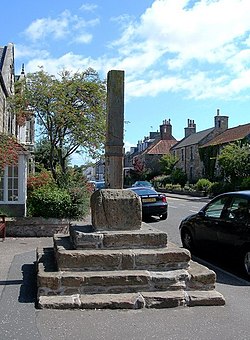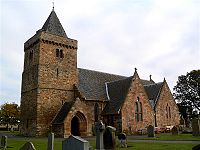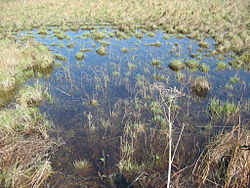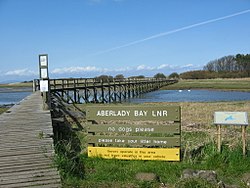Aberlady: Difference between revisions
No edit summary |
|||
| Line 32: | Line 32: | ||
[[File:Aberlady wetlands.jpg|right|thumb|250px|Aberlady Bay wetlands]] | [[File:Aberlady wetlands.jpg|right|thumb|250px|Aberlady Bay wetlands]] | ||
[[File:Aberlady Bay Footbridge.jpg|right|thumb|250px|Aberlady Reserve Footbridge]] | [[File:Aberlady Bay Footbridge.jpg|right|thumb|250px|Aberlady Reserve Footbridge]] | ||
In 1952, Aberlady Bay became the United Kingdom's first Local Nature Reserve. Amongst its other conservation designations are | In 1952, Aberlady Bay became the United Kingdom's first Local Nature Reserve. Amongst its other conservation designations are those of Site of Special Scientific Interest; Special Protection Area; and Ramsar site. The council provides Reserve Wardens. | ||
Waterston House, overlooking Aberlady Bay, is the headquarters of the Scottish Ornithologists' Club (SOC). It is named after George Waterston, the founder of the Royal Society for the Protection of Birds. | Waterston House, overlooking Aberlady Bay, is the headquarters of the Scottish Ornithologists' Club (SOC). It is named after George Waterston, the founder of the Royal Society for the Protection of Birds. | ||
| Line 38: | Line 38: | ||
The Library holds over 3,500 items and is said to be the largest ornithological library in Scotland. | The Library holds over 3,500 items and is said to be the largest ornithological library in Scotland. | ||
The art gallery space is named after wildlife artist Donald Watson who was President of SOC. The gallery specialises in bird-related paintings, but in May 2008 it had a textile exhibition named "Flights of Fancy". | The art gallery space is named after wildlife artist Donald Watson who was President of the SOC. The gallery specialises in bird-related paintings, but in May 2008 it had a textile exhibition named "Flights of Fancy". | ||
The author Nigel Tranter was inspired to write on his daily walks on the nature reserve. A cairn in his memory stands at the car park by the wooden footbridge; Nigel Tranter referred to it as "the bridge to enchantment". | The author Nigel Tranter was inspired to write on his daily walks on the nature reserve. A cairn in his memory stands at the car park by the wooden footbridge; Nigel Tranter referred to it as "the bridge to enchantment". | ||
Latest revision as of 09:31, 20 July 2017
| Aberlady | |
| East Lothian | |
|---|---|
 Aberlady market cross | |
| Location | |
| Grid reference: | NT465798 |
| Location: | 56°-0’36"N, 2°51’36"W |
| Data | |
| Population: | 873 (2001) |
| Post town: | Longniddry |
| Postcode: | EH32 |
| Dialling code: | 01875 |
| Local Government | |
| Council: | East Lothian |
Aberlady is a coastal village and parish in East Lothian. It stands on Aberlady Bay, five miles north-west of the county town, Haddington, and about 18 miles east of Edinburgh, to which it is linked by the A198 Dunbar - Edinburgh road.
Aberlady Parish Church dates back to the 15th century though it was re-built in 1887. In 1986, the ecclesiastical parishes of Aberlady and Gullane were merged, and the Manse is now in Gullane.
Aberlady is surrounded by several well-known golf courses including Luffness, Kilspindie and Craigielaw
History
In the Middle Ages, Aberlady was an important harbour and was designated "Port of Haddington" by a 1633 Act of Parliament. However, its origins are much earlier.

Aberlady had strong links with the monasteries at Iona and Lindisfarne from the 7th century, and its role was to facilitate the pilgrim traffic between the two sites. Previous archaeological excavations have shown traces of a Culdee chapel, and a pope, Gregory X, made reference to the church which he called "Aberlefdi". The 8th century Aberlady Cross fragment can be seen at the National Museum of Scotland in Edinburgh. A reconstruction of this finely carved cross was erected in 2011 by Aberlady Conservation & History Society.
The "Aberlady Heritage Project" is a community-led project, and in 2008 it surveyed three sites - the mediæval harbour quay commissioned in 1535, the Iron Age fort and associated souterrain at Kilspindie, and the Anglo-Saxon town site at the Glebe. Aberlady boasts the largest collection of stray Anglo-Saxon finds yet discovered in Scotland.
Conservation


In 1952, Aberlady Bay became the United Kingdom's first Local Nature Reserve. Amongst its other conservation designations are those of Site of Special Scientific Interest; Special Protection Area; and Ramsar site. The council provides Reserve Wardens.
Waterston House, overlooking Aberlady Bay, is the headquarters of the Scottish Ornithologists' Club (SOC). It is named after George Waterston, the founder of the Royal Society for the Protection of Birds.
The Library holds over 3,500 items and is said to be the largest ornithological library in Scotland.
The art gallery space is named after wildlife artist Donald Watson who was President of the SOC. The gallery specialises in bird-related paintings, but in May 2008 it had a textile exhibition named "Flights of Fancy".
The author Nigel Tranter was inspired to write on his daily walks on the nature reserve. A cairn in his memory stands at the car park by the wooden footbridge; Nigel Tranter referred to it as "the bridge to enchantment".
Aberlady Conservation & History Society is the local focus for conservation in the built and natural environment of the village and its surroundings.
Outside links
- Aberlady Community Association & Village
- Scottish Natural Heritage webpage for Aberlady LNR
- Aberlady Conservation Society and Aberlady Heritage Project